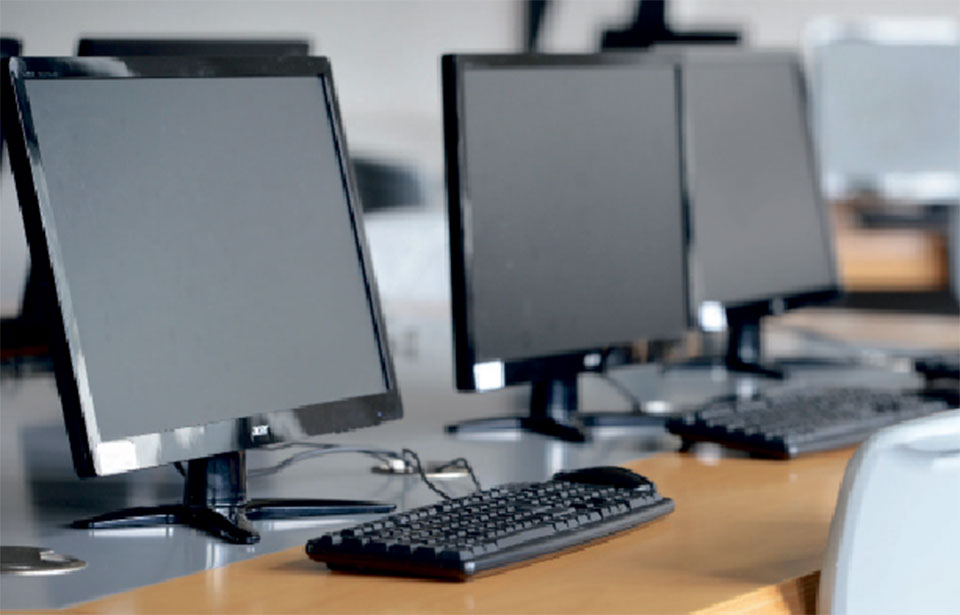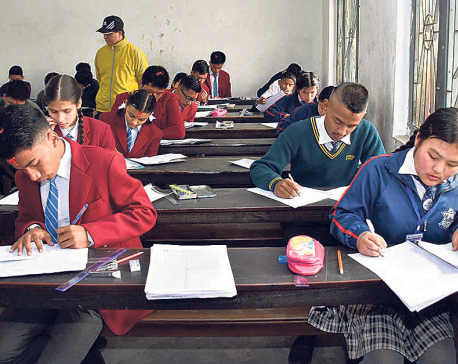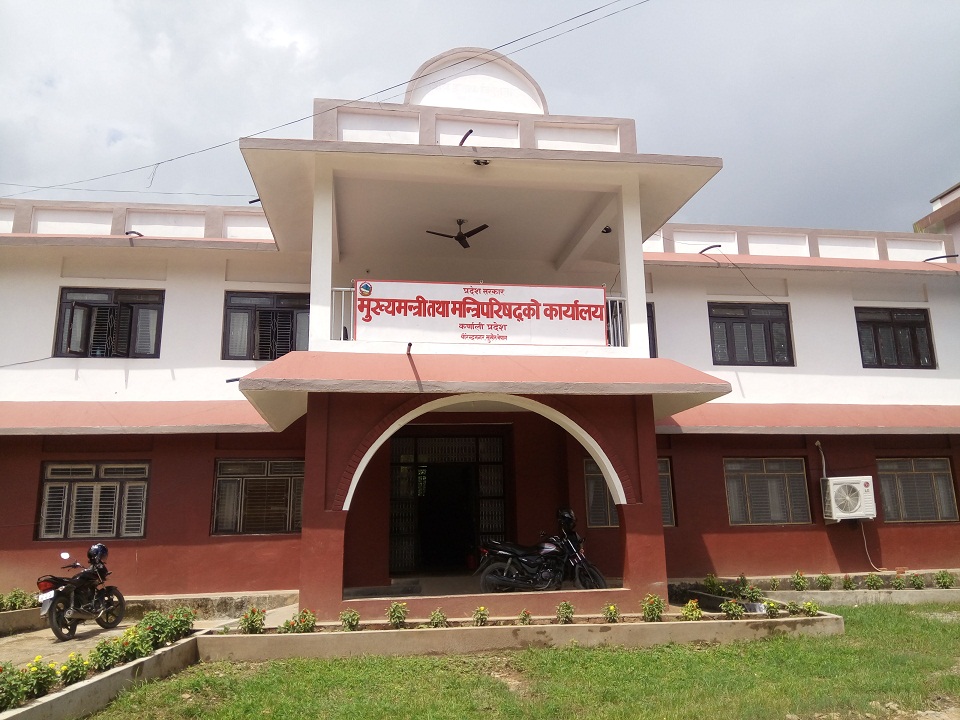
OR

Computers in schools do not mean much unless teachers belive their use will enhance learning
Out of more than 4, 00,000 students appearing for SEE examinations this year, there will be thousands who will be appearing their Computer Science paper. Out of these thousands, there will be a significant sizeable population who will be appearing the subject without having used or even seen computers throughout their school life thus far.
In our bid to ‘keep-up with modern times and modern technologies we have made a bold decision to make this particular subject mandatory for our school kids. The utter injustice that we have done to the students by making them study a ‘applied’ subject without providing them any access to use those very machines in their learning process speaks volumes about our inability to implement any plan in a proper way.
But the story does not end there. Even in schools where students have access to computers, there are ample evidences to suggest that they are not being used in the manner envisaged. Why? Perhaps the best answer is nothing but reluctance on the part of the teacher.
Why does anyone use any technology? The answer might sway in either direction depending on how you perceive the question. If you think of it as a simple question then the answer might be simple—like we use it because it is there. Conversely, if you think it as a profoundly philosophical question you could very well find yourselves scratching your head.
Whatever the case, there is always some rationale behind our use of any technology. Theories suggest that our use or non-use of technology is guided by various factors like social influence or subjective norms, our belief that its use will ease our work resulting in better work performance. In case of Nepal, which is not much different from rest of the countries, various studies have shown that there is a strong desire to use technology but lack of facilitating environment to actually use it makes is impossible.
Computer in classroom
Although there is no official data regarding the use of technology in teaching/learning process in public schools of Nepal, the soon to be released project evaluation report of ICT in Education Master Plan 2013-2017 mentions quite a few interesting details. To begin with, approximately 9500 schools have been equipped with at least two computers and a printer in our endeavor to make schools go ‘e’. There is virtually no data available which distinguishes how many schools have been able to integrate computers, internet, and other tools in teaching learning process apart from mentioning that a certain number of schools were able to set up AV rooms. The detail of what were shown in those AV rooms to augment teaching-learning process is very unclear. There’s no denying that infrastructural investment must be the first step. In the case of the last five years of ICT in Education Master Plan implementation, 8137 schools have been provided with NPR, 1,40,000 by DoE with the remaining matching grant of Rs 60,000. That’s a huge investment. In addition, 1582 schools have been provided with Rs 6,50,000 each to set up an ICT lab.
Why cannot teachers uptake a new technology? There could be myriad problems that deter them from using them. It perhaps is worth recalling them.
To begin with, the teachers are under undue pressure to become “digital experts.” While there might be possibilities of students being “digital natives” primarily through the use of cellular phones, comfortable with and immersed in technology, they depend on teachers to learn through digital means. The curriculum requires teachers to develop students’ general information and communication technology (ICT) capabilities across all fields of study, alongside the “technologies” curriculum. Hence, the constant struggle between expectation from teachers and what they actually know plays the role of a major deterrent in its use. Teachers are expected to learn computers but are unaware of boundaries within which to perform.
Not all students or teachers who use computer at home are frequent users and have sufficient data or internet access in Nepal. There is a digital divide creating challenges for teachers if they have to set different tasks for different students.
Our socio-cultural settings also tell us that we need to work hard. Or rather, best results are produced by those working the hardest which necessarily isn’t the truth. Moreover, the number of classes and number of children that a particular teacher has to take care of, also interpreted in student-teacher ratio number, is way too high. The recent data shows that overall a public school teacher has to teach as much as thrice the number of people in institutional or private schools. Teachers are expected to teach as many as seven lessons in a day leaving no room to explore ways of using technology. Given this backdrop, it’s extremely difficult for teachers to take time out to seek ways to integrate technology.
Unsound judgment
The performance of a teacher is and should be judged on how well their students do in not just exams but all walks of life. Incidentally, there is no perfect way of measuring it. As a result, the only benchmark for students’ performance, and in turn a teachers’ performance, is made based on how well the student does in variables that are easily quantifiable. Sadly, those results turn out to be nothing more than examination marks. As a result, a teacher is left wondering as to how of the official data released. It showed that only 28 percent of students from public schools managed to clear SEE last year contrasted with 92 percent from the private schools.
It could be inferred that teachers in private schools have better access to possible IT tools and hence are in a position to come up with better outcomes. However, the majority of the teachers teaching in 35000 plus schools do happen to be from public schools. Their non-use of technology is therefore firmly coupled with the fact that they lack the belief that using technology will enhance their performance. A recent report published by The Guardian mentioned that “with pupil numbers rising and an increasing proportion of teachers leaving the profession…one in five felt tense about their job most or all of the time, compared with 13% of those in similar occupations.” The underlying message is that these already stressed bunches are deprived of the opportunity in using technology as they are already over-worked.
To sum up, computers in schools do not necessarily mean much unless there is a firm belief in teachers that their use will actually enhance their work and learning outcomes.
Author is currently pursuing his PhD in Technology Management in Public Schools from Kathmandu University School of Management
You May Like This

Letter to SEE graduates
I extend my warmest congratulations on your recent SEE results. If you have achieved what you deserved, be happy. If... Read More...

School students of various hill, tarai districts yet to get all textbooks
KATHMANDU, May 27: The textbooks of at least three subjects are yet to be provided to students in various schools... Read More...

Newly-constructed school building provides relief to students
DOLKHA, July 30: Locals of Majhgaun-1 in Dolakha district have finally completed the reconstruction of quake-ravaged building of Majhgaun Lower... Read More...



Just In
- 70 community and national forests affected by fire in Parbat till Wednesday
- NEPSE loses 3.24 points, while daily turnover inclines to Rs 2.36 billion
- Pak Embassy awards scholarships to 180 Nepali students
- President Paudel approves mobilization of army personnel for by-elections security
- Bhajang and Ilam by-elections: 69 polling stations classified as ‘highly sensitive’
- Karnali CM Kandel secures vote of confidence
- National Youth Scientists Conference to be organized in Surkhet
- Rautahat traders call for extended night market hours amid summer heat

















Leave A Comment